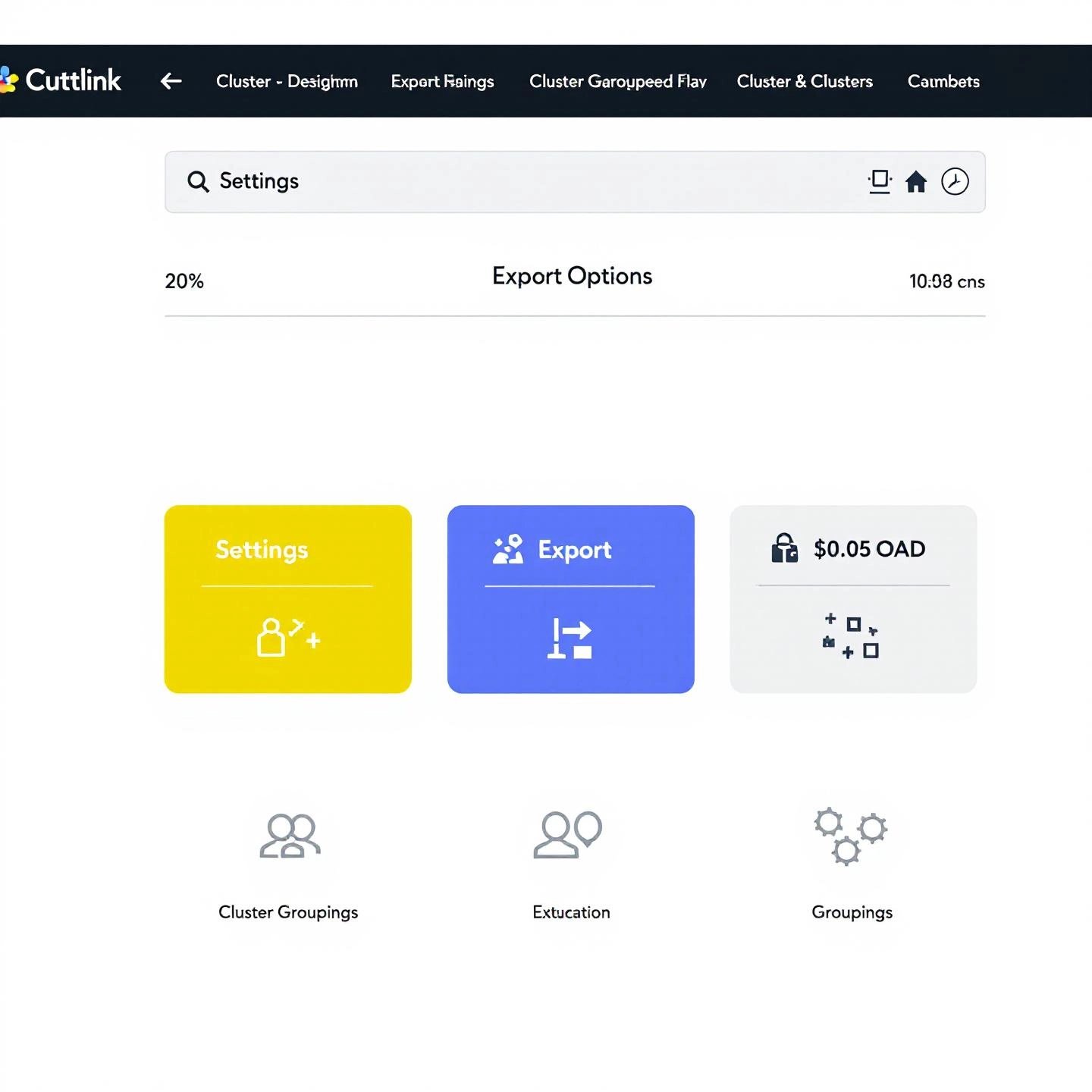Introduction to Free Keyword Clustering Tool
Ever wondered why some websites seem to cover every angle of a topic and rank for dozens—if not hundreds—of related search terms? The secret often lies in how they organize their keywords. If you’re still targeting one keyword per page, you might be missing out on a smarter, more effective SEO strategy. That’s where a free keyword clustering tool comes in.
Sounds complex? Let’s break it down. A keyword clustering or keyword grouping tool is designed to automatically organize your list of keywords into groups that are semantically and contextually related. Instead of treating each keyword as a separate target, these tools look for connections—shared meanings, overlapping topics, or common user intent—and bundle related terms together. Imagine you have a list that includes “king size mattress,” “best king mattress,” and “king mattress deals.” Rather than creating three separate pages, a keyword clustering tool would group these together, signaling that they all address the same core topic and search intent.
Why does this matter? Search engines like Google have become much more sophisticated. They no longer just match exact keywords—they interpret context, meaning, and intent behind every search. Modern algorithms can tell when different phrases are essentially seeking the same answer or solution. By grouping keywords around shared search intent, you’re aligning your content with how search engines understand and rank topics today.
- Comprehensive coverage: Each cluster reflects a broader topic, helping you create content that answers a range of related questions.
- Improved relevance: By focusing on intent, your pages better meet user needs and expectations.
- Streamlined planning: Instead of juggling dozens of single keywords, you can focus on a handful of well-defined clusters.
In short, a free keyword clustering tool is your shortcut to building a more organized, search-friendly content strategy. As you move through this guide, you’ll discover why this approach is essential for modern SEO and how to put it into practice for lasting results.

The Strategic SEO Advantage of Keyword Clustering
When you’re building a content strategy, have you ever wondered why some sites quickly become recognized authorities in their niche, while others struggle to gain traction? The answer often comes down to how well they organize and target their keywords. Enter keyword clustering—a practice that’s rapidly becoming a cornerstone of modern SEO. But why is it so powerful, and what makes it one of the best keyword clustering tool tactics for today’s digital marketers?
Why Keyword Clustering Matters for Content Strategy
Imagine you’re planning a website about personal finance. Instead of writing separate articles for “budgeting tips,” “how to save money,” and “ways to reduce expenses,” keyword clustering lets you group these related phrases into a single content cluster. This approach helps you cover a topic in depth, addressing different angles and user questions in one organized hub. Here’s why this matters:
- Builds Topical Authority: By grouping and covering related keywords, your site demonstrates expertise and depth on a subject. Search engines recognize this, often rewarding you with higher visibility for both broad and specific queries. Sites that consistently publish content clusters are more likely to be seen as trusted resources in their field.
- Improves Ranking Potential: Clustering allows a single piece of content to rank for multiple, semantically related search terms. Instead of competing for just one keyword per page, you’re casting a wider net—boosting your chances of ranking for a variety of queries within the same topic area.
- Prevents Keyword Cannibalization: One of the most overlooked keyword clustering SEO benefits is its ability to prevent your own pages from competing against each other. When keywords are grouped thoughtfully, you avoid splitting your ranking power across multiple similar pages, which can dilute your authority and confuse both users and search engines.
- Enhances User Experience: Well-structured clusters make it easier for visitors to find all the information they need in one place. This reduces frustration, increases time on site, and encourages users to explore related topics through internal links. A clear content structure also signals to search engines that your site is organized and user-focused.
Real-World Impact: From Strategy to Results
Let’s take a practical example. Suppose you operate a SaaS company and want to dominate the topic of “customer onboarding.” Instead of scattering your efforts across dozens of loosely related posts, you use a keyword clustering tool to group all relevant queries—like “onboarding checklist,” “onboarding best practices,” and “onboarding software.” You then create a comprehensive pillar page supported by detailed subpages for each cluster. This not only improves your chances of ranking for a wider set of keywords but also positions your brand as the go-to source for onboarding advice.
In summary, keyword clustering transforms scattered keyword lists into a focused, strategic content roadmap. It’s a proven way to boost topical authority, maximize your ranking potential, and deliver a seamless experience for users. As we move forward, you’ll see how free keyword clustering tools automate this process and help you put these principles into action.
How Free Keyword Clustering Tools Operate
Have you ever faced a mountain of keywords after research and wondered, “How do I turn this into a focused content plan?” That’s where understanding how keyword clustering works makes all the difference. Let’s walk through the process step by step, so you can see exactly how a free keyword clustering tool transforms scattered ideas into a strategic roadmap.
Step 1: Inputting Your Keywords
It all starts with your list. Imagine you’ve gathered hundreds—or even thousands—of keywords from sources like Google Keyword Planner, Ahrefs, or SEMrush. Instead of sorting them by hand, you upload your list (often as a CSV file) into the tool. Some platforms even let you combine multiple files or merge data from different tools, saving you time and effort.
- Upload one or more keyword lists
- Map columns (such as keyword, search volume) if prompted
- De-duplicate and clean your data automatically
Step 2: The Clustering Algorithm at Work
Here’s where the real magic happens. The tool uses algorithms to analyze your keywords and group them into clusters based on their relationships. But how does it actually make these decisions? Most free tools rely on one of two main approaches:
- Semantic Clustering (NLP-Based): The tool examines the meaning and context of each keyword, grouping those that share similar intent or subject matter. For example, “best running shoes for flat feet” and “supportive sneakers for flat arches” might be clustered together because they address the same user need.
- SERP-Based Keyword Clustering: This method checks which keywords return similar search results (SERPs) in Google. If two keywords surface the same top-ranking pages, the tool assumes they can be targeted together—since search engines see them as closely related. For instance, “Paris tourist spots” and “top attractions in Paris” might be grouped if their SERPs overlap significantly.
Some advanced tools even let you adjust the level of similarity required for clustering, but most free versions offer a straightforward, one-click process.
Step 3: Generating and Reviewing Your Keyword Clusters
Once the algorithm has done its job, you’ll receive a set of organized clusters. Each cluster typically includes:
- A primary keyword (the main focus for a piece of content)
- Several secondary keywords (related terms and variations)
- Optional data like search volume or intent category
You can often export these clusters into a spreadsheet or view them within the tool’s dashboard. This output is your ready-made content plan—each cluster can become a comprehensive blog post, landing page, or guide, ensuring you cover the topic from multiple angles.
Why This Matters for Content Planning
By automating the grouping of related keywords, these tools help you:
- Reduce manual sorting and guesswork
- Spot content gaps and opportunities
- Streamline your workflow from research to publishing
Ready to put your clusters to work? Next, we’ll explore how to evaluate the features that matter most in a free keyword clustering tool, so you can choose the best fit for your goals.

Evaluating the Best Features in a Free Keyword Clustering Tool
When you’re searching for the best free keyword clustering tool, it’s easy to feel overwhelmed by the options. Ever pasted your keyword list into a tool, only to get back clusters that make no sense—or worse, end up spending hours cleaning up the results? The secret is knowing which keyword clustering tool features actually matter for your content strategy.
What Should You Look for in a Free Tool?
Imagine you’re planning your next big content campaign. You want to group hundreds of keywords quickly, but you also need clusters that reflect real search intent—not just shared words. Here’s a breakdown of the most important features to consider, along with why each one matters:
| Feature | Why It Matters | What to Watch For |
|---|---|---|
| SERP-Based Analysis | Groups keywords by how Google actually interprets and ranks them, reducing content overlap and cannibalization. | Essential for accurate clusters. Tools using only text patterns or basic semantics often miss search intent. |
| Custom Cluster Settings | Lets you adjust cluster size, similarity thresholds, or merge/split clusters for more control. | Look for tools that offer at least some manual override or advanced settings to fine-tune results. |
| Data Export Options | Allows you to download clusters as CSV or Excel files for easy sharing and integration into your workflow. | Export flexibility is crucial for collaborating with writers or agencies and for ongoing content planning. |
| User Interface & Ease of Use | Makes the process intuitive, saving you time and reducing errors. | Choose tools with clear instructions, clean dashboards, and minimal setup steps. |
| Integration with Other SEO Tools | Seamlessly connects with keyword research, content briefs, or publishing platforms. | Integrations can save hours by streamlining your research-to-content workflow. |
| Cluster Quality & Accuracy | Ensures your clusters reflect real search behavior, not just word similarity. | Check reviews or test results—some free tools leave many keywords unclustered or create illogical groupings. |
| Workflow & Brief Generation | Some tools help you go from clusters to content outlines or briefs automatically. | This feature can be a game-changer for scaling content, especially when outsourcing writing. |
How These Features Impact Your Content Strategy
- Accurate clustering (especially with SERP-based analysis) prevents duplicate content and lets you target multiple related terms with one page—boosting your chances of ranking.
- Custom settings let you adapt clusters to your unique goals, whether you’re building broad pillar pages or highly focused guides.
- Export and integration options mean you can quickly hand off clusters to your content team, freelancers, or an AI blog writer like BlogSpark for rapid execution.
For example, if you’re planning a blog campaign on "remote work tools," you’ll want clusters that separate “best remote work software” from “remote team collaboration apps” based on how Google ranks them—not just on word overlap. A tool that provides SERP-based grouping and lets you tweak cluster size ensures you don’t miss out on ranking opportunities or waste resources on redundant pages.
Making the Right Choice for Your Workflow
While no free tool is perfect, prioritizing these features will help you avoid common pitfalls and set the stage for a scalable, effective content strategy. As you move forward, keep in mind that the best free keyword clustering tool is the one that aligns with your workflow—offering enough accuracy, flexibility, and export options to support your goals. Next, we’ll discuss the typical limitations of free tools versus paid options, so you know exactly what to expect as you scale your SEO efforts.
Understanding the Limitations
When you first discover free keyword clustering tools, it’s tempting to think you’ve found a silver bullet for your SEO workflow. But have you ever wondered why so many SEO professionals still invest in paid solutions? The answer lies in the details—the very real differences between free vs paid keyword clustering, and the limitations of free keyword tools that can impact your results.
What Sets Free Tools Apart?
Imagine you’re building a content plan for a competitive niche. You want reliable clusters that reflect how Google actually understands topics and search intent. Here’s where you’ll notice the biggest gaps between free and paid options:
- Clustering Methodology: Most free tools rely on basic pattern-matching or simple semantic analysis. They group keywords by shared words or superficial meaning, but often miss the deeper context of search intent. Paid tools, on the other hand, use live SERP-based analysis to cluster keywords by what Google actually ranks together—leading to far more accurate, actionable groups.
- Accuracy and Quality: Testing has shown that free tools can produce clusters with major overlaps, duplicate keywords, or illogical groupings. For example, the same keyword might show up in multiple clusters, or unrelated terms could be lumped together, making it hard to build focused content. Paid tools consistently deliver higher-quality clusters that align with real user intent.
- Coverage and Limits: Free tools often have restrictions on the number of keywords you can process per session or per month. Some may leave a significant portion of your list unclustered, especially with larger datasets. Paid solutions typically handle thousands—even tens of thousands—of keywords quickly and thoroughly, making them suitable for larger projects.
- Workflow Integration: If you need to move from clustering to content briefs, competitor analysis, or automated publishing, most free tools fall short. They rarely offer integrations or workflow features that streamline execution. Paid platforms often include seamless export options, direct integration with content planning tools, and even automated brief generation.
- Customization and Control: Free tools usually offer limited settings for adjusting cluster size, similarity thresholds, or manual overrides. This can make it hard to refine clusters for your unique needs. Paid tools provide advanced controls, letting you fine-tune results and adapt to changing SEO strategies.
Quick Comparison: Free vs. Paid Keyword Clustering
| Feature | Free Tools | Paid Tools |
|---|---|---|
| Clustering Approach | Pattern-matching, basic semantics | SERP-based, intent-driven |
| Accuracy | Low to moderate; often misses intent | High; aligns with Google’s results |
| Keyword Limits | Often restricted (hundreds to low thousands) | High or unlimited (thousands to tens of thousands) |
| Export & Integration | Basic CSV export; limited workflow support | Advanced export, workflow, and integration features |
| Customization | Minimal | Extensive (cluster size, similarity, manual edits) |
| Support & Updates | Limited | Ongoing support, regular updates |
When Does a Free Tool Make Sense?
If you’re managing a small project, experimenting with clustering, or working on a tight budget, free keyword clustering tools can provide a useful starting point. They’re ideal for learning the basics or handling quick, low-stakes campaigns. However, as your needs grow—or as accuracy and workflow integration become critical—the limitations of free keyword tools can quickly become bottlenecks.
In short, understanding these trade-offs helps you make smarter decisions about your content strategy. As you explore how to put your clusters into action, keep these differences in mind to ensure your SEO efforts stay efficient and effective.

Integrating Keyword Clusters into an Outsourced Content Workflow
Ever handed off a list of keywords to a freelance writer or agency and received back a patchwork of disconnected articles? If so, you’re not alone. Outsourcing content creation can be efficient, but only if you provide a clear, structured roadmap. That’s where keyword clustering for content outsourcing becomes a game-changer—turning keyword chaos into a streamlined, scalable workflow.
From Clusters to Content: Making Your Plan Actionable
Imagine you’ve just used a free keyword clustering tool and now have a tidy spreadsheet of clusters. What’s next? Instead of sending your team a jumbled list, you’ll want to translate those clusters into a concrete content plan that’s easy to follow, even for writers unfamiliar with your brand or industry.
- Define Each Cluster as a Standalone Content Asset: Treat every cluster as the blueprint for a comprehensive blog post, landing page, or resource guide. The primary keyword becomes the main focus, while secondary keywords serve as supporting subtopics or H2/H3 headings.
- Build Content Briefs with Structure in Mind: For each cluster, create a brief that includes:
- The main keyword (target for the page title and meta description)
- List of secondary keywords (to be covered in sections or FAQs)
- Suggested outline (headings that reflect the cluster’s topics)
- Internal linking recommendations (link to related clusters or pillar pages)
- Notes on search intent and user questions the content should answer
- Assign Clusters Based on Writer Expertise: If you’re working with multiple writers or agencies, match clusters to their strengths. For example, a writer experienced in technical topics might handle clusters about software, while another focuses on lifestyle content.
Streamlining the Content Workflow with Keyword Clusters
Sounds complex? It’s actually the opposite. By organizing your workflow around keyword clusters, you simplify briefing, reduce repetitive work, and make it easier for writers to deliver content that’s both comprehensive and SEO-aligned. Here’s a sample workflow to illustrate:
| Step | Action | Outcome |
|---|---|---|
| 1 | Export clusters from your tool | Organized list of content-ready clusters |
| 2 | Create structured content briefs for each cluster | Writers receive clear outlines and keyword targets |
| 3 | Assign briefs to writers/agencies | Content production begins, guided by clusters |
| 4 | Review drafts for keyword coverage and structure | Quality control ensures SEO and topic depth |
| 5 | Publish and interlink related content | Creates a network of topic-focused pages |
Why This Approach Works for Outsourced Teams
- Consistency: Every piece follows a similar structure, making your site feel cohesive—even if multiple writers are involved.
- Efficiency: Writers spend less time guessing about intent or structure and more time creating valuable content.
- Scalability: You can assign dozens of briefs at once, confident that each will contribute to your overall SEO strategy.
Many modern content platforms, like BlogSpark, are built with these principles in mind. Their workflows allow you to import clusters, generate SEO-focused outlines, and export ready-to-write briefs—making it easy for teams or agencies to deliver high-performing, search-optimized content at scale. The result? A content workflow with keyword clusters that’s not only faster but also far more effective at building topical authority and driving organic traffic.
Next, let’s explore how this structured approach to clustering can maximize your content marketing ROI and help you achieve even better results from every article you publish.

Maximizing Content ROI Through Strategic Clustering
Are you pouring time and budget into dozens of blog posts, only to see minimal results? If so, you’re not alone. Many businesses struggle to connect their content efforts to real business outcomes. The good news: a keyword cluster content strategy can be the missing link between effort and measurable return. Let’s explore how clustering can directly impact your content marketing ROI—and why it’s a smarter approach, especially if you’re outsourcing content creation.
Why One Comprehensive Article Per Cluster Outperforms Scattered Posts
Imagine you’ve identified ten related keywords for your target audience. Instead of writing ten separate, thin articles, you use content ROI keyword clustering to group these terms by shared search intent. The result? You create a single, in-depth resource that covers the topic from every angle. Here’s how this approach directly drives ROI:
- Consolidated Authority: By focusing your efforts on comprehensive articles, you build deeper topical authority. Search engines recognize this, often rewarding you with higher rankings and more organic traffic.
- Wider Keyword Coverage: A well-structured cluster lets your article rank for dozens—sometimes hundreds—of related keywords, combining their search volumes for greater reach.
- Reduced Cannibalization: Fewer, stronger pages mean your content isn’t competing against itself in search results. This boosts your chances of ranking for your most valuable terms.
- Improved User Experience: Visitors find all the answers they need in one place, increasing time on site and the likelihood of conversion.
- Lower Production Costs: Creating one robust article per cluster is more cost-effective than producing—and maintaining—a patchwork of thin, loosely related posts.
Connecting Clustering to Business Objectives
So, how does this translate to real business outcomes? Here’s what you’ll notice:
- Higher Organic Traffic: Targeting clusters means you’re not just chasing one keyword per page—you’re capturing the combined potential of all related terms.
- Better Conversion Rates: Comprehensive, authoritative content builds trust and answers more user questions, guiding visitors naturally toward your products or services.
- Faster ROI Tracking: With clear clusters, it’s easier to measure which topics drive the most engagement, leads, or sales—helping you refine your strategy for even greater returns.
Why This Matters When Outsourcing Content
When you outsource to a professional service like BlogSpark, a cluster-based approach streamlines the entire process. Instead of scattering briefs across random keywords, you hand over well-defined clusters—each mapped to business goals and user intent. BlogSpark’s AI-driven workflows can take these clusters, generate structured outlines, and deliver SEO-optimized articles that hit every angle of the topic. This means:
- Less time spent on revisions and clarifications
- More predictable, scalable results
- Content that consistently supports your marketing objectives
In short, keyword clustering isn’t just a technical SEO tactic—it’s a proven way to turn content into a true business asset. By focusing on clusters, you maximize every dollar spent, drive more traffic, and build the authority that leads to long-term growth. Next, we’ll wrap up with how free keyword clustering tools can be your launchpad for building a scalable, high-ROI content strategy—especially when paired with expert execution.
Conclusion
When you think about launching a scalable content strategy, where do you start? For many businesses, the answer is a free keyword clustering tool—a smart, accessible way to turn overwhelming keyword lists into organized, actionable plans. But here’s the real question: how do you move from that first, promising step to a truly automated, high-performing SEO content workflow?
Why Free Keyword Clustering Tools Are the Perfect Launchpad
Imagine you’re staring at a spreadsheet packed with hundreds of keywords. Sounds daunting, right? Yet, with a free clustering tool, you can instantly group those terms by search intent and topic. Suddenly, your SEO roadmap is clear and focused, making it easy to spot content gaps, avoid cannibalization, and plan comprehensive articles that cover every angle your audience cares about.
- Quick wins: Get started without a budget, making it ideal for small teams or those just testing the waters.
- Strategic clarity: Transform chaos into clusters, so you can prioritize topics that matter most for your brand.
- Foundation for growth: Lay the groundwork for more advanced SEO content automation as your needs scale.
Unlocking the True Power: Professional Execution and Workflow Integration
But let’s be honest—while free tools are a great foundation, their full potential is realized only when combined with expert execution and seamless workflow integration. That’s where many businesses hit a wall. You might have clusters, but turning them into high-quality, SEO-optimized articles at scale is another challenge entirely. This is especially true when you’re outsourcing content or managing multiple writers and projects at once.
- Consistent quality: Automated tools can group keywords, but professional content creation ensures every article meets your brand’s standards and search intent.
- Workflow automation: Integrating clusters into your editorial calendar, content briefs, and publishing systems streamlines production and reduces manual effort.
- Scalability: As your strategy grows, automation becomes essential for managing higher volumes without sacrificing accuracy or brand voice.
How BlogSpark Bridges the Gap for Scalable SEO Content
So, how do you bridge the gap between a free keyword clustering tool and a truly scalable, automated content operation? Platforms like BlogSpark are designed to do just that. By combining intelligent keyword discovery, SEO-focused outlining, and seamless workflow integration, BlogSpark empowers you to:
- Import keyword clusters and instantly generate detailed, SEO-optimized content briefs
- Maintain a consistent brand voice across every article—even when outsourcing to multiple writers
- Automate repetitive tasks, freeing up your team to focus on strategy and creativity
- Export content directly to your CMS or share with collaborators, supporting true SEO content automation
In short, a free keyword clustering tool gives you the map, but it’s platforms like BlogSpark that provide the engine to reach your destination at scale. If you’re ready to take your content strategy from organized planning to high-performance execution, explore how BlogSpark can help you turn clusters into real business results—and finally make scalable SEO content automation a reality.
Frequently Asked Questions
1. What is a free keyword clustering tool and how does it help SEO?
A free keyword clustering tool automatically organizes large keyword lists into semantically related groups based on shared search intent. This helps you create comprehensive content that aligns with how search engines interpret topics, boosting topical authority and improving your chances of ranking for multiple relevant terms.
2. How does keyword clustering improve content planning?
Keyword clustering streamlines content planning by grouping related terms, allowing you to focus on creating in-depth articles for each cluster. This approach prevents keyword cannibalization, ensures better topic coverage, and makes it easier to brief writers, especially when outsourcing content.
3. What features should I look for in the best free keyword clustering tool?
Key features include SERP-based analysis for accurate intent grouping, custom cluster settings for flexibility, easy data export options, and a user-friendly interface. These features help ensure your clusters are actionable and integrate smoothly into your content workflow.
4. What are the main limitations of free keyword clustering tools compared to paid ones?
Free tools often use basic algorithms, may have limited accuracy, restrict the number of keywords you can process, and offer fewer workflow integrations. Paid tools typically deliver higher-quality clusters, more customization, and advanced export or integration features.
5. How can I use keyword clusters to maximize content ROI when outsourcing?
By turning each keyword cluster into a detailed content brief, you enable writers to create comprehensive, SEO-optimized articles that target multiple related terms. This approach is more efficient and effective than producing many thin posts, helping you achieve better rankings and higher returns from your content investment.




